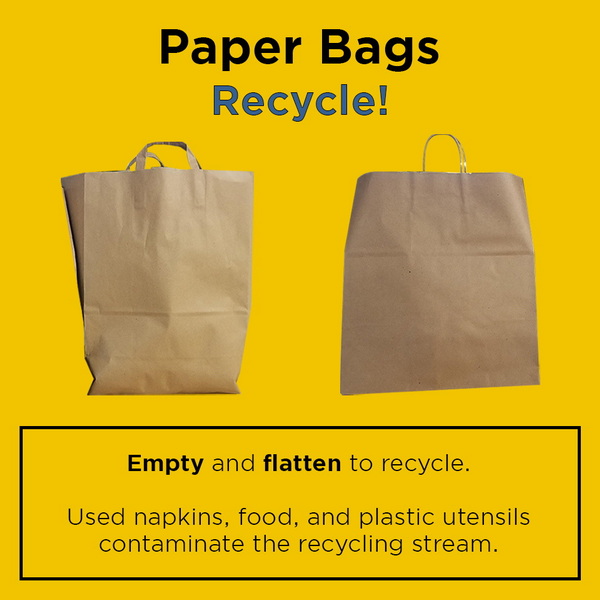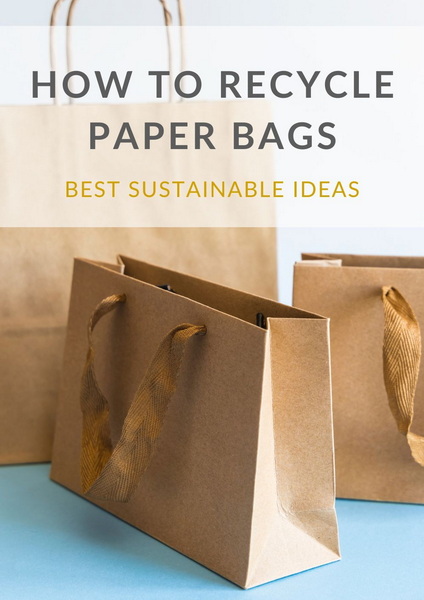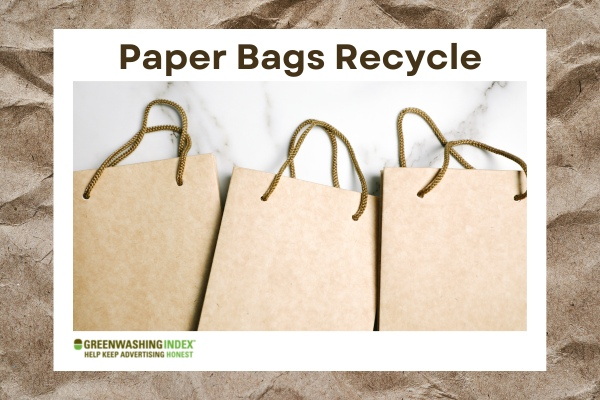Content Menu
● The Recycling Process of Paper Bags
>> Collection
>> Transportation to a Recycling Facility
>> Sorting at the Facility
>> Pulping
>> Refining and Bleaching
>> Pressing and Drying
● Types of Paper Bags That Can Be Recycled
● Benefits of Recycling Paper Bags
>> Conservation of Resources
>> Reduction in Pollution
>> Less Landfill Load
>> Economic Benefits
● Best Practices for Recycling Paper Bags
>> Keep Them Clean
>> Remove Non-Paper Elements
>> Check Local Guidelines
>> Flatten Your Bags
>> Avoid Overloading Your Bin
● Creative Ways to Reuse Paper Bags
● Environmental Considerations
>> Energy Consumption
>> Water Usage
>> Carbon Footprint
● Conclusion
● Related Questions
>> 1. Are all types of paper bags recyclable?
>> 2. Can I recycle wet or soiled paper bags?
>> 3. Do I need to remove handles from my paper bag before recycling?
>> 4. What happens if I recycle contaminated paper products?
>> 5. How can I find out about local recycling programs?
● Citations:
In recent years, the focus on sustainability and environmental responsibility has led to a significant increase in the use of paper bags. Unlike plastic bags, which contribute to pollution and take hundreds of years to decompose, paper bags are biodegradable and recyclable. However, understanding how to recycle paper bags effectively is crucial for maximizing their environmental benefits. This article explores the recycling process for paper bags, the types of paper bags that can be recycled, best practices for recycling, and creative ways to reuse paper bags.

The Recycling Process of Paper Bags
Recycling paper bags involves several key steps that transform used bags back into new paper products. Here's a detailed overview of the recycling process:
Collection
The first step in recycling is simply collecting your used paper bags. It is helpful to keep a dedicated bin for paper recycling near your kitchen or wherever you tend to unpack groceries. This way, instead of automatically throwing the bags into the trash, you're reminded to recycle them.
Transportation to a Recycling Facility
Most cities in the U.S. and many other parts of the world have curbside recycling programs, which make it easy to recycle paper products. Simply place your paper bags in the designated recycling bin and set it out for collection on recycling day. If your area doesn't offer curbside recycling, you may need to transport the bags to a local recycling facility.
Sorting at the Facility
Once at the recycling center, paper bags are sorted by material type. Kraft paper bags are typically sorted with other paper products, but because they're heavier, thicker paper, they may undergo a slightly different recycling process than items like newspaper or office paper. Sorting is crucial because if non-paper contaminants (like plastic liners or metal fasteners) make their way into the mix, they can ruin the batch.
Pulping
After sorting, the bags are shredded and mixed with water to create a slurry known as pulp. This pulp is cleaned and filtered to remove any remaining contaminants, such as glue or ink. The de-inking process is particularly important for printed bags, as the ink must be stripped from the fibers to ensure that the new paper is clean and high-quality.
Refining and Bleaching
The next step is refining the pulp to improve the strength and quality of the fibers. At this stage, the fibers are usually bleached to remove any residual color. Some recycling facilities use environmentally friendly bleaching agents like hydrogen peroxide, while others may still use chlorine-based bleaches, which can be harmful to the environment.
Pressing and Drying
Once the pulp has been refined, it's spread into thin sheets, pressed to remove excess water, and dried. The resulting paper is rolled onto large spools and is now ready to be used in the production of new paper bags or other paper products.
Types of Paper Bags That Can Be Recycled
While many types of paper bags are recyclable, not all are created equal. Here's a breakdown of common types of paper bags and their recyclability:
- Brown Paper Grocery Bags: These are typically recyclable as long as they are clean and free from food residues.
- Paper Lunch Bags: Similar to grocery bags, these can be recycled if they do not contain grease or food.
- Shopping Bags: Many shopping bags made from kraft paper can be recycled; however, those lined with plastic or coated with glossy finishes may not be accepted.
- Gift Bags: Gift bags can be tricky; if they have plastic coatings or decorative elements like ribbons or metallic finishes, they may not be recyclable.
- Takeout Bags: These are often contaminated with food and grease; thus, they should generally be disposed of in the trash unless they are clean.
Benefits of Recycling Paper Bags
Recycling paper bags offers numerous environmental benefits:
Conservation of Resources
Every time you recycle a paper bag, you're giving trees a break. This means fewer forests getting cut down—quite literally—which is fantastic news for our leafy green friends and critters that call them home.
Reduction in Pollution
Producing new bags from scratch is energy-intensive and pollutes air and water significantly more than recycling does. Recycled ones cut down this mess by using less energy and emitting fewer pollutants into the atmosphere.
Less Landfill Load
Recycling keeps these items out of landfills and gives them another shot at being useful products instead of contributing to waste accumulation.
Economic Benefits
Recycling programs create jobs in collection, sorting, processing, and manufacturing new products from recycled materials.

Best Practices for Recycling Paper Bags
To ensure that your recycling efforts are effective, follow these best practices:
Keep Them Clean
Before placing your paper bags in the recycling bin, make sure they are free from food residues, grease, or any contaminants. Dirty or soiled bags can spoil an entire batch of recyclables.
Remove Non-Paper Elements
If your paper bag has plastic handles or other non-paper components (like foil), remove these before recycling. Most recycling facilities cannot process these materials.
Check Local Guidelines
Always check your local recycling guidelines regarding what types of paper products are accepted in your curbside bin or at drop-off locations.
Flatten Your Bags
Flattening your paper bags before placing them in the recycling bin helps save space and makes it easier for sorting machines at recycling facilities.
Avoid Overloading Your Bin
Do not cram too many items into your recycling bin; this can lead to contamination and make it difficult for recyclers to sort materials properly.
Creative Ways to Reuse Paper Bags
Before tossing your used paper bags into the recycling bin, consider these creative reuse ideas:
- Gift Wrapping: Use old shopping or lunch bags as eco-friendly gift wrap.
- Book Covers: Cover textbooks or notebooks with brown paper grocery bags for a personalized touch.
- Craft Projects: Get crafty by using paper bags for various art projects or DIY home decor.
- Storage Solutions: Use them as makeshift storage containers for organizing small items around your home.
- Compost Material: If you have a compost pile, shredded clean paper can be added as a carbon source.
- Bin Liners: Paper bags make great bin liners for dry waste.
- Fire Starters: Fill them with kindling for an easy fire starter.
- Weed Mats: Lay down flattened bags in gardens before covering with mulch to suppress weeds.
- Packing Material: Use crumpled paper bags as packing material when shipping fragile items.
- Draining Oil: Place fried foods on a bag after cooking to absorb excess oil.
- Ripening Fruits: Place fruits like bananas in a bag to speed up ripening by trapping ethylene gas.
- Storing Vegetables: Store mushrooms in them where they absorb moisture without causing spoilage.
Environmental Considerations
While there are many benefits associated with using and recycling paper bags, it's essential also to consider their environmental impact compared to alternatives like plastic:
Energy Consumption
Producing new paper products requires significant energy input compared to producing plastic items—approximately 2,622 megajoules for producing 1,000 paper bags versus 763 megajoules for plastic[9].
Water Usage
The production process for paper consumes a considerable amount of water—about 1,004 gallons per 1,000 paper bags compared to only 58 gallons for 1,500 plastic ones[9].
Carbon Footprint
Studies have shown that while both types have environmental impacts, traditional plastic production results in lower greenhouse gas emissions than producing equivalent amounts of disposable paper products[4][9].
Conclusion
Recycling paper bags is an essential part of reducing waste and promoting sustainability in our daily lives. By understanding how to recycle them properly and exploring creative ways to reuse them before disposal, we can contribute positively to our environment while minimizing our reliance on single-use plastic products.
As we continue to embrace eco-friendly practices, every small effort counts toward creating a cleaner planet for future generations.
The journey doesn't end at the recycling bin; it's about rethinking our choices—picking eco-friendly alternatives whenever possible—and supporting local efforts that boost recycling rates.

Related Questions
1. Are all types of paper bags recyclable?
Yes, most types of plain brown grocery bags and lunch sacks are recyclable if they are clean and free from contaminants; however, some shopping and gift bags may not be recyclable due to plastic coatings or embellishments.
2. Can I recycle wet or soiled paper bags?
No; wet or soiled paper bags should not be recycled as they contaminate other recyclables. It's better to dispose of them in the trash.
3. Do I need to remove handles from my paper bag before recycling?
If the handles are made from non-paper materials like plastic or string, they should be removed before recycling; however, you can leave on handles made from paper.
4. What happens if I recycle contaminated paper products?
Contaminated items can spoil an entire batch of recyclables at processing facilities leading them to reject whole loads of material.
5. How can I find out about local recycling programs?
Check your city's official website or contact your local waste management authority for information on what materials are accepted in your area's recycling program.
Citations:
[1] https://whatisgreenliving.com/how-to-recycle-paper-bags/
[2] https://www.greenwashingindex.com/paper-bags-recycle/
[3] https://earth911.com/recycling-guide/how-to-recycle-paper-bags/
[4] https://perfectpackaging.org/environmental-impact-of-plastic-vs-paper/
[5] https://mygreentoddler.com/paper-bag-uses/
[6] https://www.texasdisposal.com/blog/recycling-paper-plastic-bags/
[7] https://jetpaperbags.com/blogs/paper-bag-blogs/benefits-of-recycled-paper-bags
[8] https://www.totallypromotional.com/paper-bag-recycling-information.html
[9] https://news.climate.columbia.edu/2020/04/30/plastic-paper-cotton-bags/
[10] https://www.paperbagco.co.uk/blogs/news/top-5-benefits-of-using-paper-bags-in-2023
































